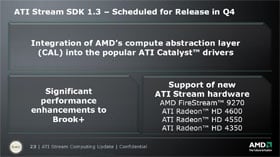AMD ATI Stream Computing Update
ATI Stream is essentially a amalgamation of all of ATI's previous initiatives like Close To Metal (CTM), Compute Abstraction Layer (CAL), and Brook+ (AMD’s modified Brook open source compiler), encompassed under a single brand. The goal, as NVIDIA has done to some degree with CUDA and PhysX, is to not only take ATI Stream mainstream, but to also better serve the enterprise and HPC spaces with easier access and standardized programming tools.
As they have been made more and more programmable over the years, it has become obvious that GPUs are well suited to accelerating more than just graphics. With ATI Stream, AMD plans to work with developers in an attempt to leverage the power of the GPU to enhance the functionality of media creation, office productivity, and entertainment applications, among others as well. According to representatives from AMD, stream and / or GPU computing are well suited to a number of multimedia-related applications, like sound / music editing and obviously graphics / design applications, as we have seen recently with Adobe's CS4 announcement. But there are also plans to accelerate desktop and office productivity applications--perhaps by speeding up searches or navigating massive databases--and operating system functions as well, i.e Aero Glass, etc. And in the entertainment space, obviously accelerating graphics is priority, but advanced physics and AI could benefit from ATI Stream as well.
Starting with the Catalyst 8.12 driver release (tentatively due Dec. 10), ATI Stream related software will be built into the driver suite. With the Catalyst 8.12 release, every user of a ATI Radeon HD 4000 series cards automatically gains the ability to run ATI Stream-enabled applications. AMD is also releasing a brand new version of the free AVIVO video converter that's accelerated by the GPU. AMD also pointed out, that they have been working with companies like Cyberlink, ArcSoft, Microsoft, Adobe, and others to to deliver ATI Stream enabled applications in the coming months.
In an attempt to ease application development, AMD is updating their free and open ATI Stream SDK as well, setting a path to DirectX and Open CL compliance. With ATI's Stream SDK v1.3 release, which is due sometime this quarter, AMD is integrating CAL (Compute Abstraction Layer) into the the ATI Catalyst drivers, incorporating major performance enhancements to Brook+, and adding support for the latest Radeon HD 4000-series hardware. The ultimate goal is to move past proprietary solutions to simplify cross-platform programming and firmly establish some industry standards.
To that end, AMD and Aprius are also announcing the Computational Acceleration System (CA8000), which features a rack-mountable 4RU chassis that can house up to eight Firestream 9270 cards. The CA8000 also features advanced PCIe optics with multi-fiber optical cable with MTP connectors (up to 50m lengths) and up to four PCI Express x16 buses.
AMD is also using the occasion to unveil the AMD FireStream 9270 stream processor. The specifications of the Firestream 9270 include a 750MHz core clock, 2GB of 3.6Gbps (900MHz) GDDR5 RAM, and a max board power of 160 watts. The Firestream 9270 offers up to 1.2 TeraFLOPS or 240 double precision GFLOPS of compute performance as a standalone card, but of course multiple cards can be used in a cluster for even more performance.











